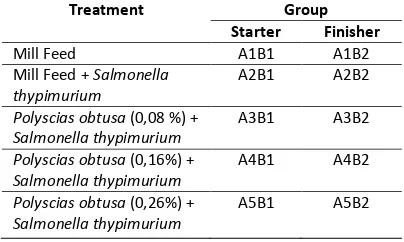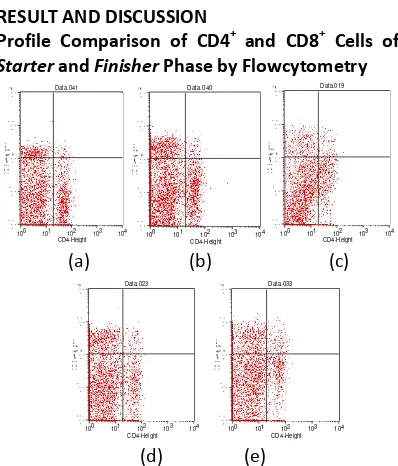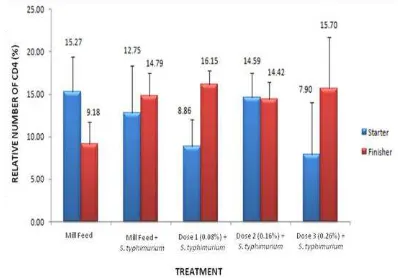Mobilization of CD4
+, CD8
+, and B220
+on Broiler Chicken Spleen with Feed
Contained Polyscias obtusa Post Infection of Salmonella typhimurium
Andi Rizki Adi Pradana, Muhammad Sasmito Djati*,
Muhaimin Rifa’i
Laboratory of Animal Physiology, Department of Biology, Faculty of Mathematics and Natural Sciences Brawijaya University, Malang
ABSTRACT
Farmers in Indonesia used to provide feed with additional antibiotics to prevent the endemic disease in poultry such as New Castle Disease and Avian Influenza. This has a negative impact because the antibiotic residues will accumulate in meat and harmful to consumers. The aim of this research was to determine the role of simplicia Polyscias obtusa leaves as immunostimulants in broiler feed that had been infected with Salmonella typhimurium. Sixty of DOC (days old chicks) with initial weight 37 g were used in this experiment. The broilers were offered diets containing different levels of simplicia leaves of as follows; 0% with no infection (A1), 0% (A2), 0,08% (A3), 0,16% (A4), and 0,26% (A5). At day 14
th , the broiler orally infected with 108 CFU/ml Salmonella typhimurium, 500 µl for each broiler. Treatments were allocated in a completely randomized design. The variable observed were the relative number of lympohcyte cell CD4+, CD8+, and B220+ of spleen analyzed by flowcytometry. The results obtained showed that additional simplicia Polyscias obtusa
leaves in feed can significantly affect the development (relative number) of lymphocytes cell, especially T cells CD8+. Treatment A4 (P. obtusa 2
nd
dose (0.16%) + S. typhimurium infection) had the best ability to increase the relative number of lymphocytes cell. These result strengthens Polyscias obtusa role as one of immunostimulatory agent, in terms of its active compounds (saponins and flavonoids).
Keywords : Broiler, immunostimulants, lymphocyte cell, Polyscias obtusa, spleen.
INTRODUCTION*
Indonesia as a country with a wet tropical climate is one of the sites where the development of both pathogenic viruses and bacteria occurred easily. To overcome such problems, Indonesian stock farmer always use additional antibiotics in broiler chicken feed. Broiler is specified chicken for meat production. Broiler chicken could produce large quantities of meat. Each body parts of broiler chicken are in different form, the back contained more bones, more muscular thigh and tenderer breast with less fat. Broiler chicken had digestive organs in form of evolved suitable tract which directed for flying purpose. Broiler chicken has no teeth and jaw bones [1].
Sustainable feed consumption with additional antibiotics for broiler chicken leads to antibiotics residues accumulation in meat, due to its
uncomplete secretion. Furthermore,
supplementary continuous feeding with
additional antibiotic was also triggered target
bacteria or microorganism resistance.
*
Correspondence Address Muhammad SasmitoDjati Email : msdjati@ub.ac.id
Address : Department of Biology, Faculty of Mathematics and Natural Sciences, Brawijya University, Jl. Veteran, Malang 65154
Consequently, it is required additional food that can improve immune system of broiler chickens, so it can be an alternative to the use of antibiotics feed and safe for consumers.
Such additional feed is leaves of Kedondong laut (Polyscias obtusa), which is one of ethnomedicinal herbs with diverse savor. Choice on this herb based on it active compounds such as saponin and flavonoid. Saponin was known for its character on membrane permeability changes, as immunostimulants and anticarsinogen agent [2]. While flavonoid is one of substantial antioxidant to prevent free radical. Flavonoid was known acted as antibacteria, antiviral, antiinflammation, antialergy, antimutagenic, antitrombotic, and vasodilatation activity [3]. Flavonoids also play an important role in
inflammatory reactions when infections
happened [4].
Lymphocytes cell development in broiler
chicken also maximized by Salmonella
typhimurium bacteria as infection agent.
to do elimination, where antibody in blood circulation unable to reach progress antigens in cells [6,7,8]. Active compounds in Polyscias obtuse plant were expected to enhance lymphocytes cells development which is very important in immunity function of broiler chicken, so that conventional feed usage with antibiotic contents can be reduced.
METHODS
This research was conducted on March to July 2012 in Laboratory of Microbiology and Laboratory of Animal Physiology, Department of Biology, Laboratory of Biomedic, Faculty of Medical School, and Field Laboratory of Sumber Sekar-DAU, Faculty of Animal Husbandry, Brawijaya University.
Material and Equpments
Equipments used during the study period are petri dishes, test tubes, wire, microtube, syringes, pipettes and micropipette, suction ball, graft and oose needle, objects and glass cover, vortex, incubator, chicken feed containers, and ice box. five treatments, with two different groups based on broiler growth phase.
Table 1. Research Design
Treatment Group
Starter Finisher
Mill Feed A1B1 A1B2
Mill Feed + Salmonella thypimurium
A2B1 A2B2
Polyscias obtusa (0,08 %) +
Salmonella thypimurium
A3B1 A3B2
Polyscias obtusa (0,16%) +
Salmonella thypimurium
A4B1 A4B2
Polyscias obtusa (0,26%) +
Salmonella thypimurium
A5B1 A5B2
Confirmation Test
XLD (Xylose Lysine Deoxycholate) test media
Pure isolates that will be tested sampled with oose and conducted streak plateon XLD media,
then incubated in 370C temperature for 24 hours. Test will show a positive result when the streak region formed black colonies.
Catalase Test
Isolate of S. typhimurium bacteria from NA media subculture were taken one oose, then moved (aseptically) to object glass which etched with 3% hydrogen peroxide (H2O2). Positive results showed by the occurance of air bubbles.
Gram Staining Test
Positive colonies obtained from selective test on XLD media were taken one graft, inserted into KIA (Kligler Iron Agar) and LIA (Lysine Iron Agar) media, then withdrawn and formed a line along the media. Next step is incubating in 37oC temperature for 24 hours. Formed colonies were
black colored due to the generation of H2S.
Pathogenicity Test
Standard Curves of Cells Number
100 101 102 103 104
for 24 hours. 6 ml culture taken and mixed with 54 ml of NB media. Then sampling performed in every 1 hour, by taking it 4 ml and added 500 µl of formalin. Absorbance of each suspension per one hour was assessed by spectrophotometer on 600 nm wavelength and the number of cell was counted with haemocytometer.
Manufacture of the Conversion Feed
Manufacture of conversion feed was by mixing some material which had varies function, with major function as nutrition sources to enhance broiler chicken growth. Conversion feed were made by mixing each composition with
Oral Infection of Salmonella typhimurium
Salmonella typhimurium bacteria in Nutrient Broth was centrifugated in 10.000 rpm for 10 minutes with 250 C. Obtained pellet then resuspended with physiological saline solution NaCl 0,9% then taken as much 500 µl and fed
homogenates then moved into propylene tubes, added PBS till 12 ml. Then it was centrifugated in 2500 rpm, 4oC for 5 minutes. Supernatant removed and obtained pellet was homogenized with 1 ml PBS, taken 50 µl, moved into microtube, and centrifugated again in 2500 rpm, 4oC for 5 minutes. Last was 100-200 µl antibody addition then homogenated in 100 µl PBS.
Flowcytometry Analysis
Isolated lymphocytes cells of spleen then added with antibody Rat anti-CD4, Rat anti-CD8 and RAT anti-CD45 conjugated to PE label for CD4 cell, Per CP for B220 cell, and FITC for CD8 cell. Conjugated results incubated for 15 minutes in ice box. The sample then added with 1 ml PBS placed inside flowcytometer cuvette. Then
choosed acquire and the flowcytometer
calculated the total cell number and the number of cells detected by labeling antibody. Obtained
Starter and Finisher Phase by Flowcytometry
The profiles (Fig 2 and 3) showed a significance increase on relative cell number of either CD4+ or CD8+ based on growth of broiler chicken. Distinctive CD8+ cell, different treatment (dose of P. obtusa leaves simplicia in feed) also affected relative cell number growth. Best treatment for increasing relative cell number of CD8+ either on starter or finisher is Treatment A4
(P. obtusa dose 2 (0,16%) + S. Typhimurium
infection). The highest relative number on starter is 19,77%, whereas finisher phase is 35,69%.
Comparison of Average Cell Relative Number of CD4+, CD8+, and B220+ on Spleen Organ of Broiler Chicken in Starter and FinisherPhase
Result of analysis of variance or ANOVA showed that cell relative number of CD4+ on starter and finisher phase was significantly different (p<0,05). It showed that cell relative number of CD4+ affected by treatment period (different growth phase), nonetheless it was not affected by different treatments. Age factor is one determinants of immunity system in avian to had optimal works, beside external factor such as dose of infected antigen virulence ability [9].
Fig 4. Relative Cell Number of T CD4+ (%) Starter and Finisher Phase
Increasing of relative number of CD4+ was needed to maximize important character enrolled by the cell itself. T helper CD4+ Cell can secreted IL-2 cytokines which serves as stimulus (growth factor) for other lymphocytes cell such as cell B. Activated T helper CD4 will proliferate and differentiate into effector cells that secrete IFN-γ to activate macrophages [6,7,8].
Based on ANOVA, relatives cell number of CD8+ on starter and finisher phase in different treatment were significantly different (p<0,05). It indicated that relative cell number of CD8+ besides treatment period, were also affected by the difference of treatment (including the
different dose of P. obtusa simplicia in feed). The highest relative cell number of CD8+ either in starter or finisher is Treatment A4 (P. obtusa dose
2 (0,16%) + S. typhimurium), were starter phase had average value of 14,56%, and finisher phase 29,30%.
Fig 5. Relative Cell Number of T CD8+(%) Starter and Finisher Phase
Figure 5 showed that T CD8+ cell had the hidhest relative cell number compare to the other profile lymphocytes cell. It can be assumed from the nature of Salmonella typhimurium
which is an intracellular facultative bacterium. Facing this pathogenic bacterium, immune system majorly handled by cellular immune responds (cell mediated immunity). Activated lymphocytes cell CD8+ will proliferate and differentiate into cytotoxic cell T (CTL) which can kill cell with microbes in its cytoplasm. Those microbes may be a virus which infected many types of cells, or bacteria that has been ingested by macrophage but had escaped from phagocytic vesicle and moved to cytoplasm (where it safe from phagocytic system which commonly rely on the vesicle) [6,7].
Fig 6. Relative Cell Number of B220+(%) on Starter dan
Results on ANOVA showed that relative cell number of B220+ neither on starter nor finisher phase were not significantly different (p>0,05). The highest relative cell number of B220+ either
Low relative number of B cells can be caused by the mechanism of B cells performance itselves. Cell B is the only cells that produce antibodi [5,8]. Some pathogenic bacteria (including Salmonella typhimurium), parasite, and virus were replicated inside antibody undetected cells, because antibody only reaches the antigen within blood circulation and ouside cell. Because of that, this pathogen destruction needs the role of lymphocytes T cells as cell mediated immunity (cellular immunity) [5].
These results confirm the role of Polyscias obtusa as one of immunostimulator agent, so that it can be an alternative to the requirement of broiler feed. Addition of immunostimulator compound increase lymphocytes respond and lead to cell proliferation [11,12,13,14]. Immunostimulation ability of this Polyscias obtusa can not be separated from its active compound, such as saponin and flavonoid. Flavonoid is an antioxidant compound that stimulates immune system by increasing the chelating and chemotaxis of lymphocytes [7,8,15]. While saponin itself was acted as anti fungal and anti bacteria, in avian (e.g. chicken), saponin functioned as additional compound to stimulate immunity system [16].
CONCLUSION
Feeding administration with addition of leaves simplicia of Polyscias obtusa in this research significantly affected the development (relative number) of lymphocytes cells, particularly on T cell CD8+ which had the highest relative cell number compare to the other two lymphocytes cell profile. This confirmed the role of Polyscias obtusa as one of immunomodulator agent, reviewed from its active compound. The best treatment performance in increasing relative number of lymphocytes cell is Treatment A4 (P. obtusa dose 2 (0,16%) + infection of S.
typhimurium). Results of ANOVA showed that T cell CD8+ development with the highest relative rate is not only affected by treatment period, but also affected by different treatments (including
the difference dose of P. obtusa simplicia in
[3] Miller, A.L. 1996. Antioxidant flavonoids: structure, function and clinical usage. Alt Med Rev 1: 103-111.
[4] Lee, D. 2008. Vietnamese Ginseng.
http://Vietnam Overseas - A Worldwide Resource for Vietnamese Culture, Business, and Telecommunication/2008/November. mht. Accessed March 8th 2012.
[5] Jawetz E., Melnick J.L., Adelberg E.A., Brooks G.F., Butel J.S., Ornston L.N. 1996.
Medical Microbiology, 20th Edition. Jakarta : EGC
[6] Abbas A.K., Lichtman A.H., Pober J.S. 2000.
Cellular and Molecular 4 ed. USA: W.B. Saunders Company.
[7] Rifa'i M, Kawamoto Y., Nakashima I., Suzuki H. 2004. Essential roles of CD8+CD122+ regulatory T cells in the maintenance of T
cell homeostasis. The Journal of
experimental medicine, 200 (9): 1123-1134. [8] Shi Z., Rifa’i M., Lee Y.H., Shiku H., Isobe K.,
Suzuki H. 2008. Importance of CD80/CD86– CD28 interactions in the recognition of target cells by CD8+CD122+ regulatory T cells. Immunology, 124 (1): 121-128. [9] Thorns, C.J., I.M. Mc Laren & M.G. Sojka
1994. The Use of Latex Agglutination to Specifically Detect Salmonella Enteritidis. Int. J. Food Microbiol.
[10] Janeway C. A., Paul T., Mark W., Mark J. S. 2001. Immuno Biology. 5th Edition. Garland Publishing, New York.
[11] Wijayanti, L. 2005. Lymphocytes Poliferation Activities Post Toxoplasm Dissolved Protein Intranasal Immunization during Toxoplasma gondii Infection. BioSMART 7 (1): 9-13. [12] Rifa'i M., Shi Z., Zhang S.Y., Lee Y.H., Shiku
[13] Shi Z., Okuno Y., Rifa'i M., Endharti A.T., Akane K., Isobe K., Suzuki H. 2009. Human CD8+CXCR3+ T cells have the same function
as murine CD8+CD122+ Treg.
European journal of immunology, 39 (8): 2106-2119.
[14] Endharti, A.T., M. Rifa'I, Z. Shi, Y. Fukuoka, Nakahara, Y. Kawamoto, K. Takeda, K. Isobe, H. Suzuki. 2005. Cutting edge: CD8+CD122+ regulatory T cells produce IL-10 to suppress IFN-gamma production and proliferation of CD8+ T cells. Journal of immunology, 175 (11): 7093-7097.
[15] De la Fuente, M. dan V.M. Victor. 2000.
Anti-oxidants as modulators of immune function. Immunology and Cell Biology 78: 49-54.
[16] Cheeke, P.R., McNitt, J. I., & Patton, N.M.
2000. Rabbit Production. 8
th


